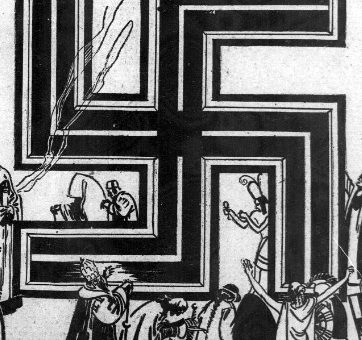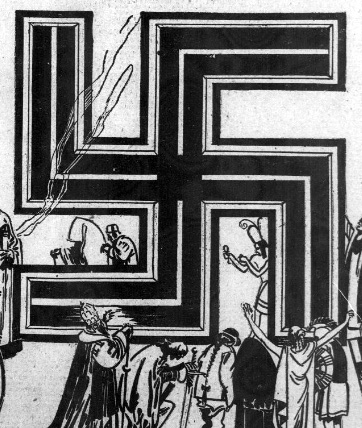
Before The Third Reich and the Nazi Party, the swastika was a very popular symbol in the United States. The article below was published in 1907 and basically talks about how the symbol has global significance.
While somewhat slow, the most interesting part of this article is on Atlantis. I have broken the article down into sections so that you may read only the parts that interest you.
The Swastika
By Mary Ogden Vaughan
In view of the widespread interest shown during the last few years in that oldest of all known symbols, the swastika, it is somewhat astounding to learn that its very name was so comparatively unknown a little over a decade ago that it did not appear in Webster’s or Worcester’s dictionaries, in the Encyclopedia Britannica or in a dozen other standard works of reference by English and American authors. Neither was it in works on art, archaeology, mythology, folklore and antiquities, where the student might naturally expect to find allusions to it.

And yet the symbol itself is found wherever the foot of man has trod, throughout the civilized and uncivilized world. Generally speaking, there is no nation and no tribe the world around which has not made use of the swastika at some period of its history since the recorded beginnings of time – be those records in stone of clay, in base or precious metals, in pigment, papyrus or parchment; woven in tapestries or wrought in basketry.
The swastika is at the same time the oldest and the most widely diffused symbol in the world, and an interest in it once awakened one need never lack a fascinating object of study and pursuit. As a hobby, one may ride it to the ends of the earth and back again without exhausting it, and a catalog of the places visited on the way would be a geography of the earth’s surface.
It will be found in the tombs of the pyramids and the catacombs, in the medieval missals of Europe, on gold filagree ornaments exhumed from buried cities of the ancient Etruria and carved on totem poles in Alaska, tattooed on the skin of the devout in Tibet and placed – as a sacramental sign – on the bodies of their dead; on the oldest coins of Sicily, India, Corinth and Byzantium; on Chinese and Japanese porcelains, bronzes, old armor and battle flags; on Persian rugs and on Indian blankets. It is used as a crest by a noble family in Japan, and as a branding iron for cattle in Circassia. Known to the cave dweller, the cliff dweller and the lake dweller; in the age of iron, the age of bronze and the age of gold; in the old time Rome and classic Greece; literally “from Greenland’s icy mountains to India’s coral strand”; dug up from the very wells of ancient Troy; used by the aboriginal inhabitants of North and South America, by the people of the occident and the people of the orient, one may well ask whence it came and how it was so widely dispersed among all the people of the earth.
Meaning
And the meaning of the swastika is as varied as its habitat, but always of good omen, or religious significance. It is a talisman, a charm, a protection from the “evil eye.” A sign of benediction, of blessing, of good fortune, of long life. Emblem of ancient deities – mythical or real – it is the holy sign of Vishnu, as of Buddha, and known and reverenced by Brahman as well as Buddhist.
It is the lucky sign of the Jain religionists. It is the symbol of the sun god, of the rain god, of the wind god and of the four quarters of the globe. Among the Chinese it stands also for a great number – for infinity – which they express as “ten thousand.” No symbol has given rise to so many interpretations as this mystic cross.
The Prince of India
General Lew Wallace, in “The Prince of India,” relates that the prince showed the sign (of the swastika) to Mohammed. It was set in silver on a leaf of ivory, and carried as a precious relic by the prince, who said it was the symbol of “The pure secret of the eye of right doctrine,” whose innermost mysteries were entrusted to one of his ancestors by the great Buddha himself. To the prince had descended the office of “keeper” of this secret.
Mohammed said to him, “Give me its meaning,” but the prince replied: “Nay, my lord. Did I that, the doctrine, of which they made me keeper, would be no longer a secret. The symbol is of vast antiquity. There is never a genuine image of Buddha without it over his heart.”
The Little Clay Cart
As to its origin and original meaning, they are lost in the shadows of antiquity. The sign must have existed long before it was named, and the Sanskrit word swastika, the accepted name among scholars of today is, of course, unknown among primitive tribes and peoples, where it has many names. There is a Sanskrit play called “The Little Clay Cart,” written about 600 AD, which introduces the swastika symbol during the progress of the drama, and it may be of interest to note that the play was given its initial performance in this country in April 1907. The play was presented by the English club of the University of California in the open air and under the open sky in the classic Greek theater at Berkeley.
Atlantis
Ignatius Donnelly, in his “Atlantis,” which created such a sensation when it was published something like a quarter of a century ago, gives a most ingenious theory concerning the origin, the meaning and the dispersion of this symbol. His account of it is, in brief, something like this:
The lost island of Atlantis was divided into four equal parts by vast waterways – rives or canals – which were the arteries of the kingdom, and the accepted symbol of this island of delight was a circle divided equally by two bisecting lines.
When the island was submerged in the great catastrophe which buried it forever from sight of men, the inhabitants who survived and escaped in boats and canoes were scattered to the four corners of the earth. But with them went the memory of their beautiful and prosperous island home, and its symbol was used by them and their descendants all over the world as a sign of happiness and good fortune. In time the circle was indicated only by the branching arms, from left to right – the normal or true swastika.

Mystic Symbol
This is a fascinating theory, but by no means an accepted one, as the premises from which he argues are by no means accepted; but it is of interest to find that an authority of repute says the swastika is “a mystic symbol bearing a special significance and generally believed to have some connection with one of the elements – water.
Ornament
Among oriental people we find the swastika occasionally on Persian rugs, and it is in constant use among the people of China, of Korea and of Japan. It would scarcely be an exaggeration to say that two-thirds of the articles of Chinese and Japanese manufacture show it as ornamentation. Especially is this true of things made for the use of their own people.
Temple furnishings and decorations, carved jade, fans, musical instruments, bronzes, porcelains, patterns of brocade, embroideries, jewelry – all show the symbol and in the simple articles of every day use it is seldom missing.
One finds it on the cotton handkerchief in China, and on the every present blue and white towel of the Japanese, which serves him for so many purposes. As hair ornaments of Chinese women, and on the buttons of their blouses; on the crudest pottery vessels, and – repeated in an ornamental fretwork – cut in the metal of opium lamps.
Source: The San Francisco call. (San Francisco [Calif.]), 03 Nov. 1907.

